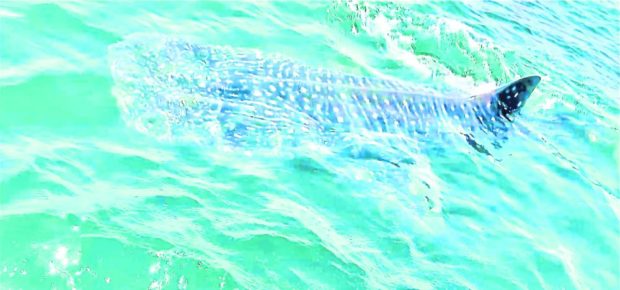Quezon folk welcome ‘butanding’ return to Tayabas Bay

GENTLE GIANT | This whale shark, or “butanding,” was sighted on Thursday at Tayabas Bay, an indication that more of the endangered animals will return to those waters after illegal fishing was banned in that area. (Photo by EDWIN FRIAS / Contributor)
LUCENA CITY, Quezon, Philippines — Whale sharks, locally known as “butanding,” have been spotted once again at Tayabas Bay about a month after the most recent storm to hit the country, according to residents of the coastal town of Sariaya and an environmental group based in Quezon province.
Jay Lim, project manager of Tanggol Kalikasan, said more than 20 butanding were seen at the bay just last week. By his estimate, the species, which goes by the scientific name Rhincodon typus, were 4.5 meters to 12 meters (15 feet to 40 feet) in length.
Before the onslaught of Severe Tropical Storm “Paeng” (international name: Nalgae) late in October, there were few butanding at the bay, Lim said.
Paeng took almost a week in its slow path across the archipelago since entering the Philippine area of responsibility on Oct. 26. Another storm followed on its heels but it weakened into a tropical depression.
Since then, the butanding have returned. Lim and Edwin Frias — a fish warden, or marine version of a wildlife officer, at Sariaya — have been taking videos of the sea creatures after they have become an almost regular sight.
Article continues after this advertisement‘More fish in our waters’
Sherwin Rosales, a fisheries technician at Sariaya’s agriculture office, said the whale sharks are “usually spotted in the vicinity of fish sanctuaries fronting the coastal villages of San Roque and Bignay 2.”
Article continues after this advertisementAccording to Rosales, whale sharks were already migrating to Tayabas Bay sometime between March and May.
The bay, located northwest of the island province of Marinduque, stretches from San Juan town in Batangas province to the towns of Sariaya, Pagbilao, Padre Burgos, Agdangan, Unisan, Pitogo, Macalelon, General Luna, Catanauan, Mulanay, and San Francisco and Lucena City in Quezon.
“With the return of more butanding,… it indicates the presence of more fish in our waters,” Rosales said.
Even the Department of Environment and Natural Resources noted the presence of whale sharks there, saying this was a sign of the bay’s “rich marine biodiversity.”
Sea patrol
Precisely for that reason, Sariaya’s fishers also welcomed the return of the butanding as they anticipated a bigger catch.
Yet not long ago, blast fishing and other irresponsible fishing methods drove the butanding out of Quezon’s waters.
In 2012, a whale shark was found dead at the coast of Atimonan town, which faces Lamon Bay on the eastern side of the province.
Fishermen said this butanding, which measured 8 meters long and 2 meters wide (27 feet long and 7 feet wide) and weighed 11 tons, was hit by a commercial fishing boat. Three years later, a sperm whale weighing around 50 tons and measuring 17 meters long (55.7 feet) was found dead also at Lamon Bay, at the coast of Calauag town. Residents there said the animal died from blast fishing.
Lim remembered Frias telling him that blast fishermen would always hold a merrymaking after every illegal catch.
“But they can’t do it anymore” after blast fishing has been banned in Sariaya, he said, adding that Mayor Marcelo Gayeta has also reinforced the local “bantay dagat” (sea patrol) with the provisions they need.
Tanggol Kalikasan continues to raise awareness about environmental laws as these concern the municipality.
“The return of butanding is a welcome sight in Tayabas Bay. It shows that the protection of our natural environment always produces a good result,” Lim said.